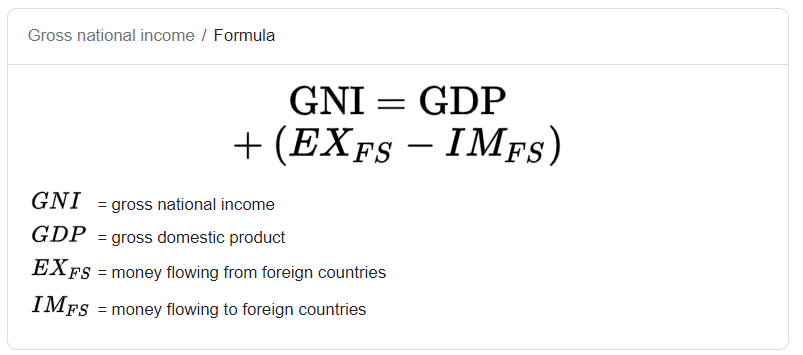Table of Contents
What is National Income?
The value of the commodities and services a nation produces in a fiscal year is referred to as national income. As a result, it represents the sum of all economic activity carried out in a nation over the course of a year and is measured in monetary terms. The terms “national income” and “national dividend,” as well as “national output” and “national spending,” are ambiguous. Understanding the definition of national income can help us comprehend this idea.
Define National Income
According to Marshall: “The labor and capital of a country acting on its natural resources produce annually a certain net aggregate of commodities, material and immaterial including services of all kinds. This is the true net annual income or revenue of the country or national dividend.”
National Income Formula
National Income Formula is given below:

National Income: Important Terms
1. Gross Domestic Product
A country’s Gross Domestic Product (GDP) is the sum of all the products produced and services provided inside its borders during a given year.
Additionally, GDP is determined as GDP at market prices and is calculated at market prices. Several components of GDP include:
- Wages and salaries
- Rent
- Interest
- Undistributed profits
- Mixed-income
- Direct taxes
- Dividend
- Depreciation
2. Gross National Product
For the purpose of calculating GNP, we must gather and evaluate data from all productive activities, including agricultural products, wood, minerals, and commodities, as well as the production contributions made by transport, communications, insurance firms, and professions such as (as lawyers, doctors, teachers, etc.) in the open market.
Net income earned overseas and brought into a nation is also included. There are four main components of GNP:
- goods and services for consumers
- Gross domestic personal income
- products made or services provided
- income from foreign sources
Join the Adda247 Saksham batch by clicking on this link.
3. Net National Product(NNP) (At Market Price)
The term “Net National Product” describes the total amount of the economy’s net output for a given year. NNP is calculated by subtracting from GNP the cost of capital asset depreciation or replacement allowance. It is written as,
NNP = GNP – depreciation allowance.
(Capital Consumption Allowance is another name for depreciation)
4. Net National Product At Factor Cost
The market value of output is referred to as NNP. The total amount of income payments provided to production factors is known as NNP at factor cost. Thus, to arrive at the net national income at factor cost, we subtract the amount of indirect taxes and add subsidies from the money value of NNP at market price.
NNP at factor cost = NNP at Market prices – Indirect taxes + Subsidies
5. Personal Income
Personal income is the entire amount of money that citizens of a nation get from all sources each year before paying direct taxes. Personal income and national income are never equal since personal income includes transfer payments whereas national income does not. Personal income is calculated by subtracting transfer payments, employee contributions to social security programmes, and undistributed corporate profits from national income.
Personal Income = National Income – (Social Security Contribution and undistributed corporate profits) + Transfer payments
6. Disposable Income
Personal disposable income is another name for disposable income. It is a person’s income after taxes have been paid. This is the available supply for consumption by families.
Disposable Income = Personal income – Direct Tax.
Since not all of the available money is spent on consumption,
Disposal income = consumption + saving.
7. Per Capita Income
Per Capita Income is the term used to describe the average annual income of a country’s population. By dividing national income by population, one can calculate per capita income.
8. Real Income
Real income is the purchasing power of nominal income, which is defined as national income expressed in terms of the average price level for a given year. The final worth of products and services generated, represented in terms of money at current prices, is known as national income. However, it does not reflect the true health of the economy. Following is how the real revenue is derived:
National Income at constant price = National Income at current price ÷ P1 / P0
9. GDP Deflator
The GDP deflator measures changes in the prices of the products and services that make up the GDP. It is a price index that is calculated by multiplying the result of dividing the nominal GDP for a particular year by the real GDP for that same year by 100.
GDP deflator = [Nominal GDP/Real GDP] x100
Found this article helpful?
Let’s connect via chat or call our senior expert counselor at +91-9625869989 to learn more about the different streams and options available.
We would love it if we could add some of your insights. If you have a definite goal of scoring the highest marks, then you can resolve your doubts via our app/quizzes and youtube class assistance (https://youtube.com/c/Adda247Class9and10)
What is National Income Define Formula?- FAQs
Ques 1. By GNP, what do you mean?
Ans. GNP is the market value of the final goods and services generated in the nation’s economy in a given year. Foreign-sourced revenue is not included in this income.
Ques 2. What is per-capita income?
Ans. Per capita income is calculated by dividing the total national income by the total population.
Ques 3. What exactly is national income?
Ans. The flow of products and services that are made accessible to a country throughout the year is known as national income.
Ques 4. In terms of NNP, what is the national income?
Ans. As a result, National Income is the sum of income that factors of production receive in the form of rent, wages, interest, and profit.



 UP, MP, CBSE Board Result 2025 Live Upda...
UP, MP, CBSE Board Result 2025 Live Upda...
 CUET UG Exam Date Sheet 2025 @cuet.nta.n...
CUET UG Exam Date Sheet 2025 @cuet.nta.n...
 NTA NEET Cut Off 2025, Expected Cutoff f...
NTA NEET Cut Off 2025, Expected Cutoff f...










